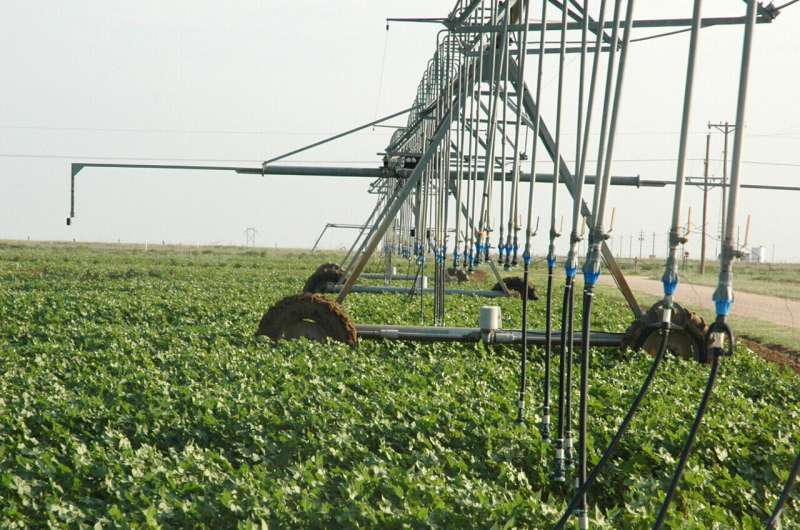Variable deficit irrigation in cotton can help improve yields, save water

Cotton producers struggling with available water after drought and dropping water tables can maximize crop yields from limited water with some planning and implementation of variable deficit irrigation, according to research by Texas A&M AgriLife Research scientists.
A team of Texas A&M AgriLife researchers recently published “Evaluation of growth-stage-based variable deficit irrigation strategies for cotton production in the Texas High Plains” in the Agricultural Water Management journal.
“This study is receiving a lot of attention from area producers who are trying to maximize their limited water,” said Srinivasulu Ale, Ph.D., AgriLife Research agrohydrologist at the Texas A&M AgriLife Research and Extension Center at Vernon and the Department of Biological and Agricultural Engineering.
“Results from this modeling study provide useful recommendations on appropriate irrigation management strategies for sustaining cotton production under different weather conditions while conserving valuable groundwater resources of the Ogallala Aquifer.”
The study simulated four irrigation deficit levels in four cotton growth stages, resulting in 256 scenarios. The goal was to identify efficient growth-stage-based variable deficit-irrigation, GS-VDI, strategies based on data from cotton irrigation water-use efficiency field experiments conducted by Bordovsky at the Texas A&M AgriLife Research Center at Halfway.
The four growth stages were: first leaf to first square, flower initiation to early bloom, peak bloom, and finally, from cutout to late bloom to boll opening. The long-term simulations reflected conditions from 1977-2019 and were conducted with four deficit levels—30%, 50%, 70% and 90% evapotranspiration replacements.
Based on the results of simulated seed cotton yield and irrigation water-use efficiency, Ale and his team concluded that different efficient GS-VDI strategies should be considered for dry, normal and wet years.
For example, a strategy of 90% evapotranspiration-replacement from first leaf to peak bloom and of 30% evapotranspiration-replacement in the final stage was found to be an ideal strategy in normal precipitation years to achieve higher seed cotton yield while saving 2.56 inches of irrigation water.
Overall, the flower initiation/early bloom and peak bloom growth stages were the most sensitive stages to water stress. The cutout, late bloom and boll opening growth stage was the least sensitive stage to water stress and water deficit during this stage did not significantly affect yield and water-use efficiency.
“We also found that the amount of irrigation water required to achieve maximum irrigation water-use efficiency was less than the amount of irrigation water required to achieve maximum seed cotton yield under all weather conditions,” Himanshu said. “By adopting GS-VDI strategies, a substantial amount of irrigation water can be saved, and it is possible to achieve high seed cotton yields with less irrigation water.”
Bell said the results indicated that the extent and timing of water deficit stress in different cotton growth stages substantially affected seed cotton yield, irrigation water use and water-use efficiency.
The results from this study could be useful for producers in the Texas High Plains region in optimizing the application of limited available irrigation water to achieve higher irrigation water-use efficiency and cotton yields.
“We believe producers can go into a normal cotton season with a strategy of 70% deficit in the fourth stage and 10% deficit in the remaining stages,” Ale said. “Our future efforts will focus on simulating the effects of GS-VDI strategies at different sites across the High Plains region to strengthen the recommendations.”
More information:
Sushil K. Himanshu et al, Evaluation of growth-stage-based variable deficit irrigation strategies for cotton production in the Texas High Plains, Agricultural Water Management (2023). DOI: 10.1016/j.agwat.2023.108222
Citation:
Variable deficit irrigation in cotton can help improve yields, save water (2023, May 31)
retrieved 31 May 2023
from https://phys.org/news/2023-05-variable-deficit-irrigation-cotton-yields.html
This document is subject to copyright. Apart from any fair dealing for the purpose of private study or research, no
part may be reproduced without the written permission. The content is provided for information purposes only.
For all the latest Science News Click Here
For the latest news and updates, follow us on Google News.

